Text
WHAT IS THE SLOWEST THING IN THE UNIVERSE??
Blog#394
Saturday, April 20th, 2024.
Welcome back,
For centuries, physicists thought there was no limit to how fast an object could travel. But Einstein showed that the universe does, in fact, have a speed limit: the speed of light in a vacuum (that is, empty space). Nothing can travel faster than 300,000 kilometers per second (186,000 miles per second).

Only massless particles, including photons, which make up light, can travel at that speed. It's impossible to accelerate any material object up to the speed of light because it would take an infinite amount of energy to do so.

So as it turns out, Einstein could never have caught up with the beam of light that captured his imagination as a teenager!
How long does it take to get to the Moon? Light travels the 380,000 kilometers (240,000 miles) between the Moon and the Earth in 1.3 seconds. It would take a person more than nine years of continuous walking to travel this distance.
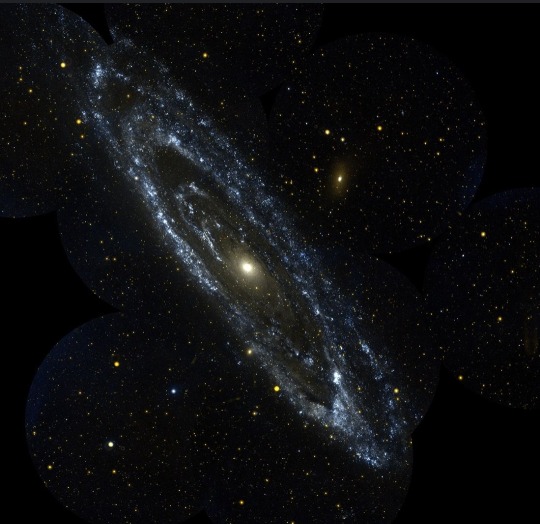
Light: 1.3 seconds
Electron: 2.9 minutes
Space shuttle (orbital speed): 14 hours
Sound (70°F): 13 days
Passenger jet: 18 days
NYC subway car (maximum speed): 220 days
Human (walking): 9 years

The faster an object travels, the more massive it becomes. As an accelerating object gains mass and thus becomes heavier, it takes more and more energy to increase its speed. It would take an infinite amount of energy to make an object reach the speed of light.
Originally published on
COMING UP!!
(Wednesday, April 24th, 2024)
"HOW FAST DOES LIGHT TRAVEL??"
#astronomy#outer space#alternate universe#astrophysics#universe#spacecraft#white universe#space#parallel universe#astrophotography
58 notes
·
View notes
Text
IS TIME AN ILLUSION??
Blog#393
Wednesday, April 17th, 2024.
Welcome back,
Why is time controversial? It feels real, always there, inexorably moving forward. Time has flow, runs like a river. Time has direction, always advances. Time has order, one thing after another. Time has duration, a quantifiable period between events. Time has a privileged present, only now is real. Time seems to be the universal background through which all events proceed, such that order can be sequenced and durations measured.
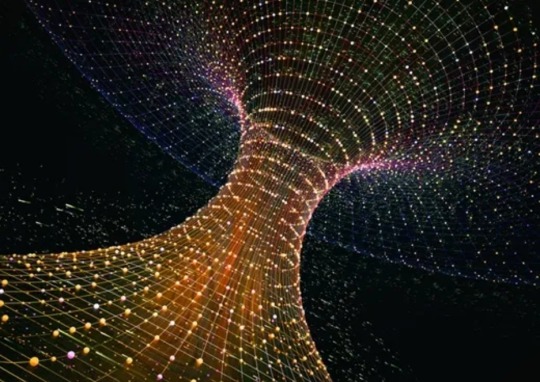
The question is whether these features are actual realities of the physical world or artificial constructs of human mentality. Time may not be what time seems — this smooth unity without parts, the ever-existing stage on which all happenings happen.
To appreciate time is to feel the fabric of reality. I interview physicists and philosophers on my public television series, "Closer to Truth," and many assert that time is an illusion. What do they mean that time is "not real?"

Huw Price, professor of philosophy at Cambridge University, claims that the three basic properties of time come not from the physical world but from our mental states: A present moment that is special; some kind of flow or passage; and an absolute direction.
"What physics gives us," Price said, "is the so-called 'block universe,' where time is just part of a four-dimensional space-time … and space-time itself is not fundamental but emerges out of some deeper structure."
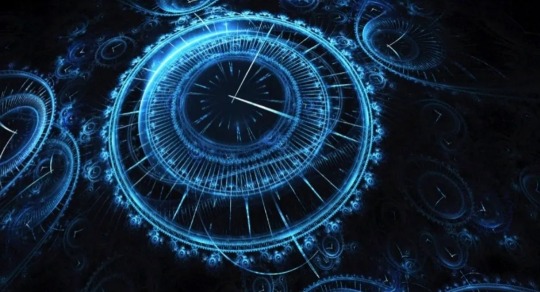
We sense an "arrow" or direction of time, and even of causation, he said, because our minds add a "subjective ingredient" to reality, "so that we are projecting onto the world the temporal perspective that we have as agents
Think of the block universe, which is supported by Einstein's theory of relativity, as a four-dimensional space-time structure where time is like space, in that every event has its own coordinates, or address, in space-time.

Time is tenseless, all points equally "real," so that future and past are no less real than the present.
So, are we being misled by our human perspectives? Is our sense that time flows, or passes, and has a necessary direction, false? Are we giving false import to the present moment?

"We can portray our reality as either a three-dimensional place where stuff happens over time," said Massachusetts Institute of Technology physicist Max Tegmark, "or as a four-dimensional place where nothing happens [‘block universe’] — and if it really is the second picture, then change really is an illusion, because there's nothing that's changing; it's all just there — past, present, future.

"So life is like a movie, and space-time is like the DVD," he added; "there's nothing about the DVD itself that is changing in any way, even though there's all this drama unfolding in the movie. We have the illusion, at any given moment, that the past already happened and the future doesn't yet exist, and that things are changing. But all I'm ever aware of is my brain state right now. The only reason I feel like I have a past is that my brain contains memories.
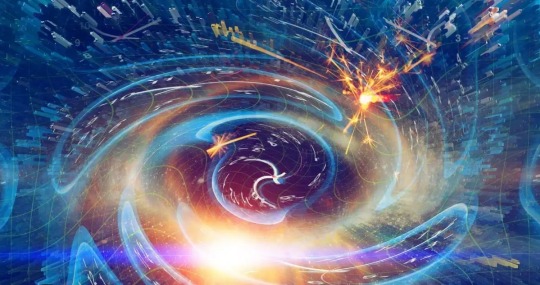
"Time is out there," said Andreas Albrecht, a theoretical cosmologist at the University of California, Davis. "It's called an external parameter — the independent parameter in the [classic] equation of motion. So, time — the time we know since we learned to tell time on a clock — seems to disappear when you study physics, until you get to relativity.
Originally published on https://www.space.com
COMING UP!!
(Saturday, April 20th, 2024)
"WHAT IS THE SLOWEST THING IN THE UNIVERSE??"
#astronomy#outer space#alternate universe#astrophysics#universe#spacecraft#white universe#space#parallel universe#astrophotography#time and space#time
83 notes
·
View notes
Text
HOW DID THE MOON FORM??
Blog#392
Saturday, April 13th, 2024.
Welcome back,
There used to be a number of theories about how the Moon was made and it was one of the aims of the Apollo program to figure out how we got to have our Moon,' says Sara.
Prior to the Apollo mission research there were three theories about how the Moon formed. The evidence returned from these missions gave us today's most widely accepted theory.
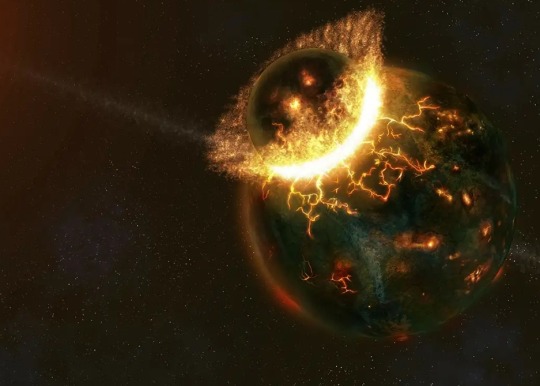
Capture theory suggests that the Moon was a wandering body (like an asteroid) that formed elsewhere in the solar system and was captured by Earth's gravity as it passed nearby.
The accretion hypothesis proposes that the Moon was created along with Earth at its formation.
The fission theory suggests Earth had been spinning so fast that some material broke away and began to orbit the planet.
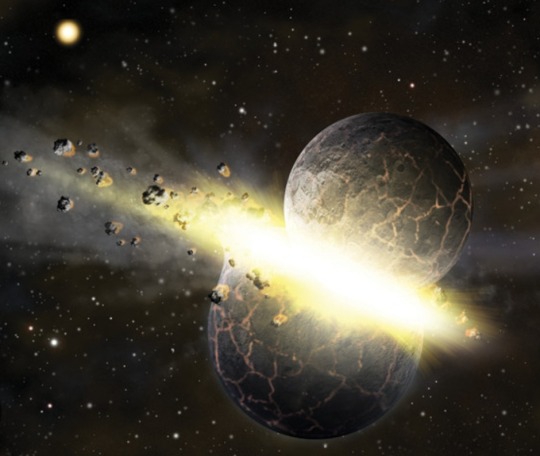
The giant-impact theory is most widely accepted today. This proposes that the Moon formed during a collision between the Earth and another small planet, about the size of the planet Mars. The debris from this impact collected in an orbit around Earth to form the Moon.
The Apollo missions brought back over a third of a tonne of rock and soil from the Moon. This provided some clues on how the Moon may have formed.

'When the Apollo rocks came back, they showed that the Earth and the Moon have some remarkable chemical and isotopic similarities, suggesting that they have a linked history,' says Sara.
'If the Moon had been created elsewhere and was captured by the Earth's gravity we would expect its composition to be very different from the Earth's.

'If the Moon was created at the same time, or broke off the Earth, then we would expect the type and proportion of minerals on the Moon to be the same as on Earth. But they are slightly different.'
The minerals on the Moon contain less water than similar terrestrial rocks. The Moon is rich in material that forms quickly at a high temperature.
'In the seventies and eighties there was a lot of debate which led to an almost universal acceptance of the giant impact model.'

Lunar meteorites are also an important source of data for studying the origins of the Moon.
'In some ways meteorites can tell us more about the Moon than Apollo samples because meteorites come from all over the surface of the Moon,' adds Sara, 'while Apollo samples come from just one place near the equator on the near side of the Moon.'
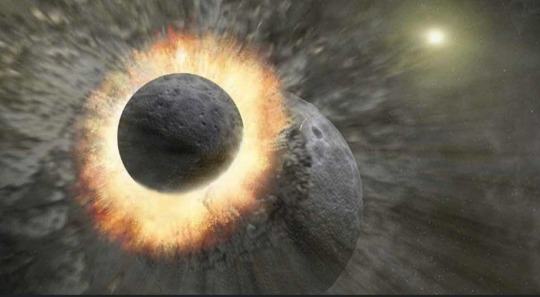
Before Earth and the Moon, there were proto-Earth and Theia (a roughly Mars-sized planet).
The giant-impact model suggests that at some point in Earth's very early history, these two bodies collided.
During this massive collision, nearly all of Earth and Theia melted and reformed as one body, with a small part of the new mass spinning off to become the Moon as we know it.
Scientists have experimented with modelling the impact, changing the size of Theia to test what happens at different sizes and impact angles, trying to get the nearest possible match.
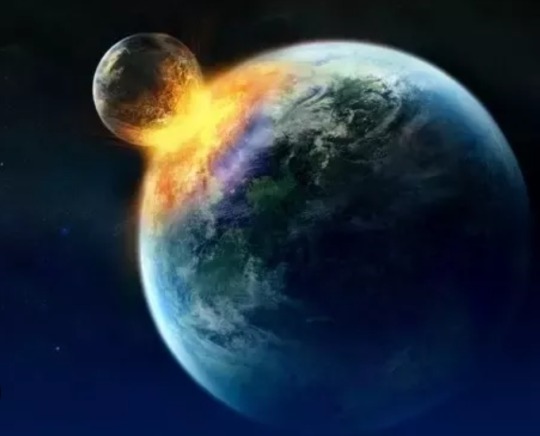
'People are now tending to gravitate towards the idea that early Earth and Theia were made of almost exactly the same materials to begin with, as they were within the same neighbourhood as the solar system was forming,' explains Sara.
'If the two bodies had come from the same place and were made of similar stuff to begin with, this would also explain how similar their composition is.'
Originally published on https://www.nhm.ac.uk
COMING UP!!
(Wednesday, April 17th, 2024)
"IS TIME AN ILLUSION??"
#astronomy#outer space#alternate universe#astrophysics#universe#spacecraft#white universe#space#parallel universe#astrophotography
51 notes
·
View notes
Text
WHY IS VOYAGER 1 SENDING GIBBERISH??
Blog#391
Wednesday, April 10th, 2024.
Welcome back,
For months now, the most distant spacecraft to Earth – Voyager 1 – has been talking gibberish on the interplanetary 'radio'.
The repetitive jumble of 1s and 0s it's sending back to our planet, 24 billion kilometers (15 billion miles) away, has made no sense to scientists until now.
Turns out, officials at NASA just needed to give the oh-so-distant craft a bit of a 'poke' to ask it how it was feeling.
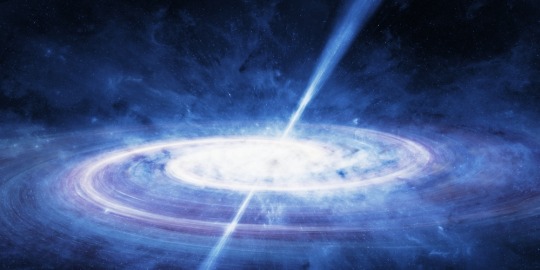
In response to a coded command sent in March, a computer onboard the Voyager called the flight data subsystem (FDS) has revealed where it hurts. This system wraps up the mission's all-important observations before beaming them back to Earth.
The system returned a software readout to Earth that scientists have now used to confirm about 3 percent of its memory is corrupted. Which is why turning the FDS on and off didn't resolve the issue back in November of 2023.

Based on the gobbledygook data the FDS is currently packaging, engineers at NASA suspect that most of the corruption is confined to a single chip in the computer's memory system.
In March, the Voyager mission team at NASA sent a so-called poke command to the FDS. Poke commands modify specific memory addresses, which is why gamers sometimes use them to cheat, by giving themselves unlimited lives or some such similar advantage.
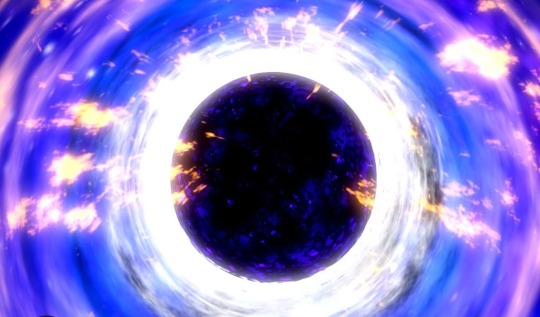
In this case, the command allowed the engineers to prompt the system into using different readout sequences in its software packages in an effort to circumvent the problem.
Thanks to the FDS' response to the poke command, received 22.5 hours later, engineers noticed that one part of the system was returning some strange readings. They appeared to be in the wrong format, and an engineer on the team was able to decode them.
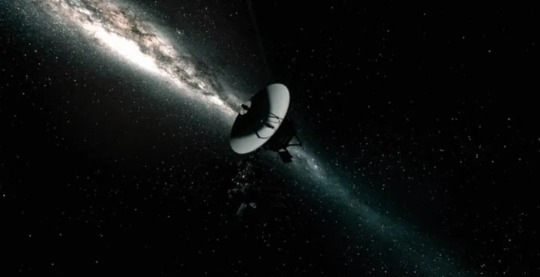
The mumbo jumbo signal contained a readout of the entire FDS memory system. Comparing this readout to one received before the issue arose, the Voyager team was able to locate the source of corruption.
No one yet knows what originally caused the corruption, but it could have come from energetic particles in space sparking damage, or simply sheer age.
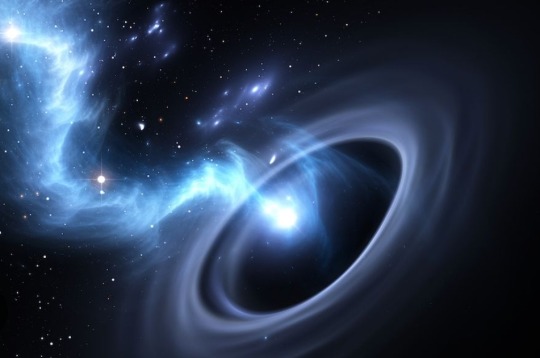
Voyager 1 has gone above and beyond its initial mission, both figuratively and literally speaking. It was designed to explore Jupiter and Saturn and was launched all the way back in 1977, which means its computers are wildly outdated.
Originally published on www.sciencealert.com/
COMING UP!!
(Saturday, April 13th, 2024)
"HOW DID THE MOON FORM??"
#astronomy#outer space#alternate universe#astrophysics#universe#spacecraft#white universe#space#parallel universe#astrophotography
104 notes
·
View notes
Text
HOW DOES A NEUTRON STAR FORM??
Blog#390
Saturday, April 6th, 2024.
Welcome back,
When a massive star explodes as a supernova at the end of its life, its core can collapse into a tiny and superdense object with not much more than our sun’s mass. These small, incredibly dense cores of exploded stars are neutron stars. They’re among the most bizarre objects in the universe.
A typical neutron star has about 1.4 times our sun’s mass. And they can range up to about two solar masses.
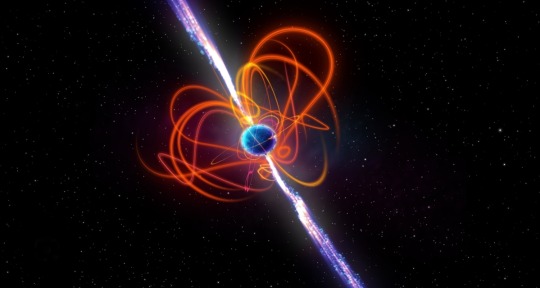
Now consider that our sun has over 100 times Earth’s diameter. In a neutron star, all that mass is squeezed into a sphere that’s only about 12-25 miles (20-40 km) across, or about the size of an earthly city.
So perhaps you can see that neutron stars are very, very dense! A tablespoon of a neutron star material would weigh more than 1 billion U.S. tons (900 billion kg). That’s more than the weight of Mount Everest, Earth’s highest mountain.

Throughout much of their lives, stars maintain a delicate balancing act. Gravity tries to compress the star while the star’s internal pressure exerts an outward push. And nuclear fusion at the star’s core causes the outer pressure. In fact, this fusion burning is the process by which stars shine.
In a supernova explosion, gravity suddenly and catastrophically gets the upper hand in the war it has been waging with the star’s internal pressure for millions or billions of years.

With its nuclear fuel exhausted and the outward pressure removed, gravity suddenly compresses the star inward. A shock wave travels to the core and rebounds, blowing the star apart. This whole process takes perhaps a couple of seconds.
But gravity’s victory is not yet complete. With most of the star blown into space, the core remains, which may only be twice our sun’s mass. Gravity continues to compress it, to a point where the atoms become so compacted and so close together that electrons are violently thrust into their parent nuclei, combining with the protons to form neutrons.

Thus the neutron star gets its name from its composition. What gravity has created is a superdense, neutron-rich material – called neutronium – in a city-sized sphere. The exact internal structure of this sphere is the subject of much debate. Current thinking is that the star possesses a thin crust of iron, perhaps a mile or so thick. Under that, the composition is largely neutrons, taking various forms the further down in the neutron star they are located.
Originally published on https://earthsky.org/
COMING UP!!
(Wednesday, April 10th, 2024)
"WHY IS VOYAGER 1 SENDING GIBBERISH??"
#astronomy#outer space#alternate universe#astrophysics#universe#spacecraft#white universe#space#parallel universe#astrophotography
62 notes
·
View notes
Text
DOES QUANTUM GRAVITY EXIST??
Blog#389
Wednesday, April 3rd, 2024.
Welcome back,
All the fundamental forces of the universe are known to follow the laws of quantum mechanics, save one: gravity. Finding a way to fit gravity into quantum mechanics would bring scientists a giant leap closer to a “theory of everything” that could entirely explain the workings of the cosmos from first principles. A crucial first step in this quest to know whether gravity is quantum is to detect the long-postulated elementary particle of gravity, the graviton.
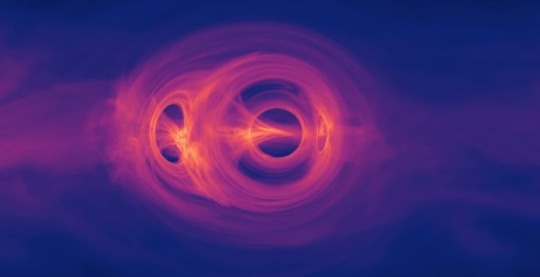
In search of the graviton, physicists are now turning to experiments involving microscopic superconductors, free-falling crystals and the afterglow of the big bang.
Quantum mechanics suggests everything is made of quanta, or packets of energy, that can behave like both a particle and a wave—for instance, quanta of light are called photons. Detecting gravitons, the hypothetical quanta of gravity, would prove gravity is quantum. The problem is that gravity is extraordinarily weak.
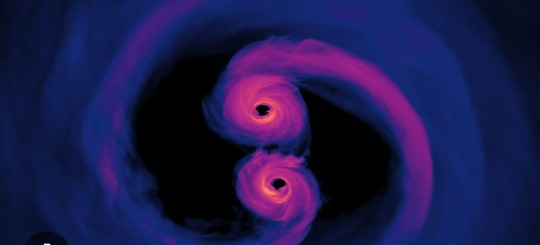
To directly observe the minuscule effects a graviton would have on matter, physicist Freeman Dyson famously noted, a graviton detector would have to be so massive that it collapses on itself to form a black hole.
“One of the issues with theories of quantum gravity is that their predictions are usually nearly impossible to experimentally test,” says quantum physicist Richard Norte of Delft University of Technology in the Netherlands. “This is the main reason why there exist so many competing theories and why we haven’t been successful in understanding how it actually works.”

In 2015, however, theoretical physicist James Quach, now at the University of Adelaide in Australia, suggested a way to detect gravitons by taking advantage of their quantum nature. Quantum mechanics suggests the universe is inherently fuzzy—for instance, one can never absolutely know a particle's position and momentum at the same time. One consequence of this uncertainty is that a vacuum is never completely empty, but instead buzzes with a “quantum foam” of so-called virtual particles that constantly pop in and out of existence.

These ghostly entities may be any kind of quanta, including gravitons.
Decades ago, scientists found that virtual particles can generate detectable forces. For example, the Casimir effect is the attraction or repulsion seen between two mirrors placed close together in vacuum. These reflective surfaces move due to the force generated by virtual photons winking in and out of existence.
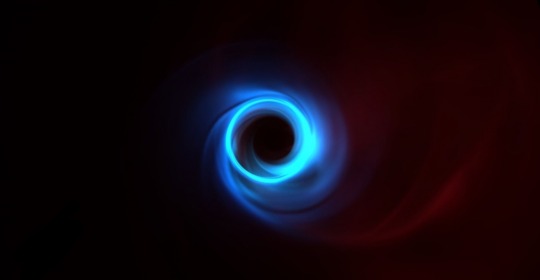
Previous research suggested that superconductors might reflect gravitons more strongly than normal matter, so Quach calculated that looking for interactions between two thin superconducting sheets in vacuum could reveal a gravitational Casimir effect. The resulting force could be roughly 10 times stronger than that expected from the standard virtual-photon-based Casimir effect.

Recently, Norte and his colleagues developed a microchip to perform this experiment. This chip held two microscopic aluminum-coated plates that were cooled almost to absolute zero so that they became superconducting. One plate was attached to a movable mirror, and a laser was fired at that mirror. If the plates moved because of a gravitational Casimir effect, the frequency of light reflecting off the mirror would measurably shift. As detailed online July 20 in Physical Review Letters, the scientists failed to see any gravitational Casimir effect.

This null result does not necessarily rule out the existence of gravitons—and thus gravity’s quantum nature. Rather, it may simply mean that gravitons do not interact with superconductors as strongly as prior work estimated, says quantum physicist and Nobel laureate Frank Wilczek of the Massachusetts Institute of Technology, who did not participate in this study and was unsurprised by its null results. Even so, Quach says, this was a courageous attempt to detect gravitons.”
Originally published on https://www.scientificamerican.com
COMING UP!!
(Saturday, April 6th, 2024)
"HOW DOES A NEUTRON STAR FORM??"
#astronomy#outer space#alternate universe#astrophysics#universe#spacecraft#white universe#space#parallel universe#astrophotography
83 notes
·
View notes
Text
IS THERE GRAVITY IN SPACE??
Blog#388
Saturday, March 30th, 2024.
Welcome back,
Gravity is the attractional force that an object with mass has on another object of mass. Every object that has mass has a gravitational impact on other objects around it. The bigger the object, the greater the gravitational force it has. Bigger objects will have a stronger effect for a greater distance, pulling in smaller objects.

What we typically think of as gravity is what keeps us here on the Earth, what pulls a dropped object to the ground. That is the gravitational attraction of the Earth pulling everything toward its core. The normal force is what we call the contact force acting upon objects that are physically associated with each other, and is the opposing force to gravity.
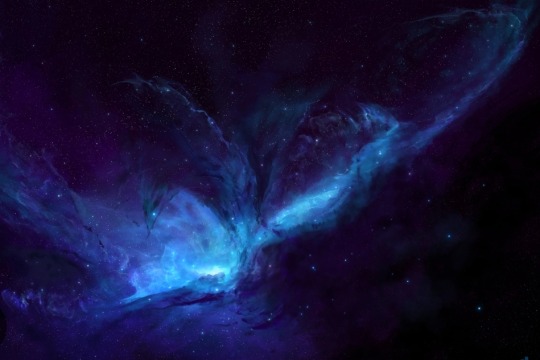
When we are standing, Earth’s gravity pulls our body towards the ground, but the normal force pushes upward against our feet, helping us to perceive gravity as weight. We are adapted to Earth’s gravitational force so we don’t often notice it unless we are out of shape/ our muscles are underutilized, meaning our muscles have to work hard to counteract it.

As stated earlier, any object with mass has a gravitational effect on other objects of mass around it, and this applies to objects in space as well. Smaller objects can be caught in orbit around larger objects because they are in freefall around the object.
An object in orbit is away from the more massive object enough and is constantly moving enough not to be pulled in, but not fast enough to overcome the larger object’s gravitational force.

Just as the Sun holds everything in the solar system in orbit around it, the Earth has a gravitational impact on objects in space around it like the Moon and both natural and artificial satellites.
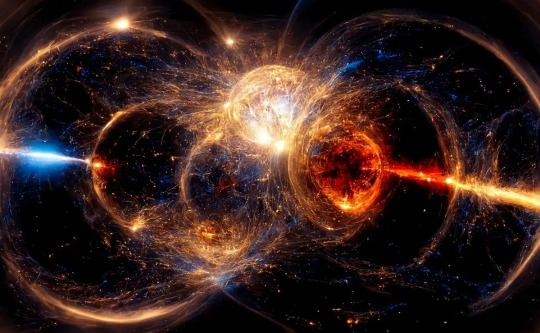
Our astronauts may be in space, but they have never left the gravitational influence of the Earth since even our furthest-seeking astronauts on the Moon were in orbit around the Earth and also experience the gravity of the Moon.
Astronauts on the International Space Station actually experience 90% of the gravity we do on Earth, but they are in freefall/ orbit around the Earth, which provides weightlessness, the state of being without apparent weight.

In contrast, Zero gravity is when you are in an environment where nothing impacts you with its gravitational force. You are not close enough to be pulled into something or all the mass around was perfectly equal, canceling out gravitational forces.
Gravity is weaker in empty space but since there are tiny particles dispersed throughout space, they still provide tiny gravitational forces. Essentially, zero gravity is a misnomer.

Reduced levels of gravity or microgravity is a more accurate term.
Back to our original question is there gravity in space? This is highly dependent on what you classify as “in space”. Depending on where you are in space, you will be acted upon by stronger and weaker gravitational forces.
Originally published on https://starlust.org
COMING UP!!
(Wednesday, April 3rd, 2024)
"DOES QUANTUM GRAVITY EXIST??"
#astronomy#outer space#alternate universe#astrophysics#universe#spacecraft#white universe#space#parallel universe#astrophotography
73 notes
·
View notes
Text
DARK MATTER DOESN'T EXIST IN OUR UNIVERSE??
Blog#387
Wednesday, March 27th, 2024.
Welcome back,
The composition of the universe, as we currently understand it, is thought to comprise 'normal matter,' 'dark energy,' and 'dark matter.' However, a recent study from the University of Ottawa sheds new light on this notion, suggesting that dark matter might not actually be a necessary component.
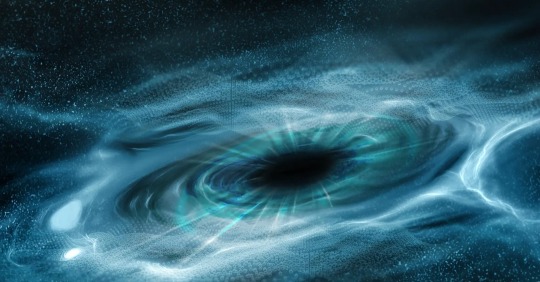
Dark matter is a term used in cosmology to describe entities that don't interact with light or the electromagnetic field, and can only be inferred through gravitational effects. Essentially, it's invisible and its composition remains a mystery, yet it plays a crucial role in our comprehension of the behavior of galaxies, planets, and stars.
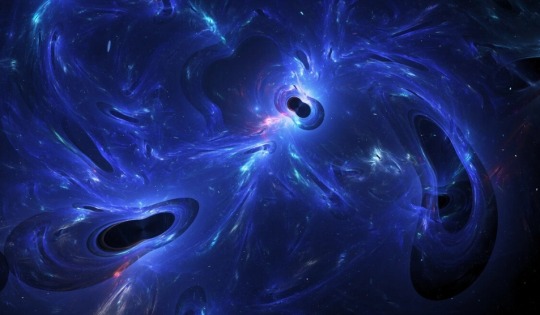
Professor Rajendra Gupta, from the Faculty of Science at the University of Ottawa, conducted this groundbreaking study. He utilized a blend of the covarying coupling constants (CCC) and "tired light" (TL) theories, amalgamating them into what's termed the CCC+TL model.
This model proposes that the forces of nature diminish over cosmic time and that light loses energy during its extensive travels.
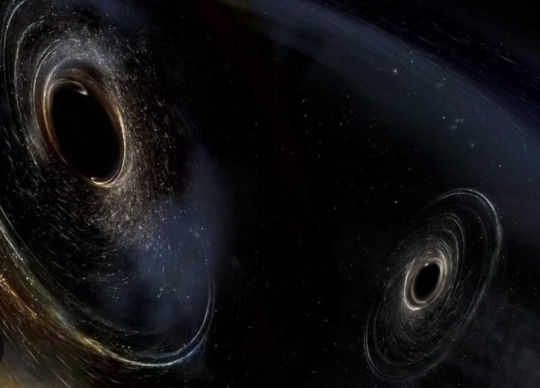
Gupta's model has been rigorously tested against various observations, including the distribution of galaxies and the evolution of light from the early universe.
This study challenges the prevailing understanding of the universe, which posits that approximately 27% of its composition consists of dark matter, with less than 5% being ordinary matter, leaving the rest attributed to dark energy.
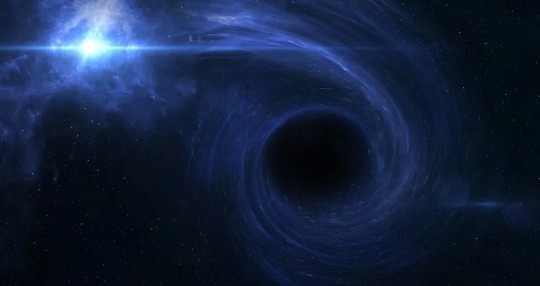
Gupta said, "The findings from our study affirm our prior research on the age of the universe, which concluded it to be approximately 26.7 billion years old, and demonstrate that the universe may not necessitate the presence of dark matter."
He further explains that while standard cosmology attributes the accelerated expansion of the universe to dark energy, it is actually the weakening of natural forces as the universe expands that drives this phenomenon, not dark energy.

The concept of "redshifts" plays a pivotal role in this study. Redshifts occur when light shifts towards the red end of the spectrum. Gupta scrutinized data from recent papers on galaxy distribution at low redshifts and the angular size of the sound horizon from literature at high redshifts.
Originally published on www.thebrighterside.news
COMING UP!!
(Saturday, March 30th, 2024)
"IS THERE GRAVITY IN SPACE??"
#astronomy#outer space#alternate universe#astrophysics#universe#spacecraft#white universe#space#parallel universe#astrophotography
97 notes
·
View notes
Text
WHAT IS MIRROR UNIVERSE THEORY??
Blog#386
Saturday, March 23rd, 2024.
Welcome back,
“The identity of dark matter represents one of the greatest mysteries of Nature, whose resolution requires new physics beyond the Standard Model,” the paper reads. “Theories of DM range from those in which its physics is closely related to the Standard Model, to those in which it is utterly alien.”
This idea falls in the latter camp.

As described by astrophysicist Paul Sutter for Live Science, the idea posits that for every interaction of normal matter in our universe, a mirror interaction occurs in the universe of dark matter. Furthermore, the study suggests that while protons and neutrons have roughly the same mass in our universe, the same is not true in this hypothetical “dark mirror” universe. This could cause protons to evaporate, creating a free-floating sea of “dark neutrons” and a universe filled with its own “dark periodic table of dark elements,” an idea that’s been proposed in previous research.
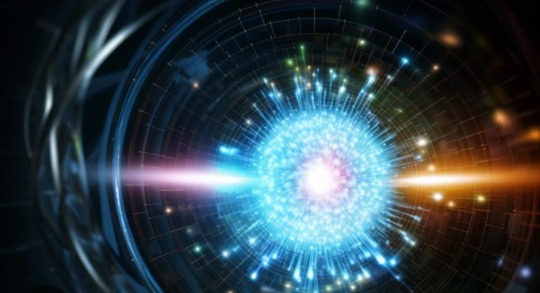
“The absence of dark protons is not sufficient to prevent the formation of atomic dark matter. If two [dark neutrons] can form a bound state (dark dineutron), bigger nuclei of pure [dark neutrons] can form during dark Big Bang Nucleosynthesis, and can grow to be very large due to the lack of electromagnetic repulsion,” the paper reads. “Such nuclei of pure [dark neutrons] are perfectly valid dark matter candidates.”
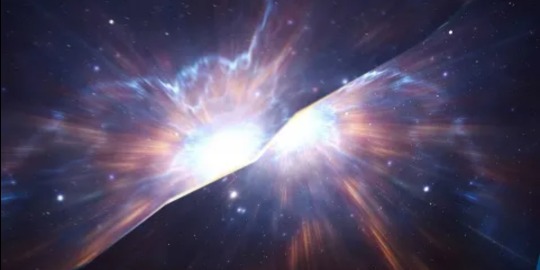
This new paper isn’t the first to propose that dark matter could be hiding in another “mirror” universe. Scientists from the University of Toronto theorize that we could theoretically glimpse “dark matter” stars that form in this other universe if they contain clumps of normal matter.

If a mirror star were to drift within the swirling gas of a nebula, for example, its immense gravitational pull—though weak—could affect normal matter in a way that’s distinct from standard matter interactions and make the mirror star observable. However, some scientists question if dark matter stars, which would be shorter lived than our normal stars, would even exist this long after the Big Bang.
That brings the search for dark matter—whether in this universe or in another “dark mirror” one—back to the same familiar game of hide-and-seek.
Originally published on www.popularmechanics.com
COMING UP!!
(Wednesday, March 27th, 2024)
"DARK MATTER DOESN'T EXIT ON OUR UNIVERSE??"
#astronomy#outer space#alternate universe#astrophysics#universe#spacecraft#white universe#space#parallel universe#astrophotography
95 notes
·
View notes
Text
IS DARK MATTER REAL??
Blog#385
Wednesday, March 20th, 2024.
Welcome back,
Astrophysicists have piled up observations that are difficult to explain with dark matter. It is time to consider that there may be more to gravity than Einstein taught us
The stars still have secrets. we know why they shine, and we know why they twinkle, but we still do not know why they move the way they move. The problem has been with us for the better part of a century. In the 1930s Swiss astronomer Fritz Zwicky observed that some galaxies in a cluster of about 1,000 fly surprisingly fast around their common center of mass.

Even with generous estimates of the individual galaxies’ masses, they did not add up enough to account for this motion. Zwicky fixed the mismatch by conjecturing the existence of a new kind of matter: “dark matter.”
In the 1970s American astronomer Vera Rubin, who died in 2016, saw the same thing happening in single galaxies. The velocities of stars far out from the center of a galaxy remained roughly the same as those closer in, when astronomers would have expected them to slow down because of the dwindling gravity at the galaxy’s far reaches. Again, the visible mass alone was not sufficient to explain the observations.
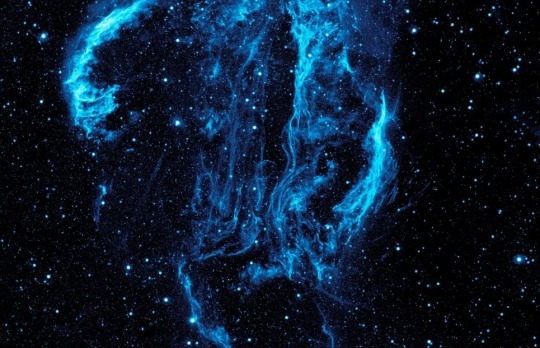
Rubin concluded that in galaxies, too, dark matter must be present.
Since then, even more evidence has accumulated that we must be missing something. The tiny temperature fluctuations in the cosmic background radiation astronomers see pervading space, as well as the gravitational bending of light around galaxies and galaxy clusters and the formation of the cosmic web of large-scale structure throughout space, confirm that normal matter alone cannot explain what we see.

For many decades the most popular hypothesis has been that dark matter is composed of new, so far undetected particles that do not interact with light. The alternative explanation that we have the right particles but the wrong laws of gravity has received little attention.
Thirty years ago this stance was justified. The idea of particle dark matter gained traction because back then physicists had other reasons to believe in the existence of new particles. Around the 1950s and 1960s physicists realized that the protons, neutrons and electrons that make up atoms are not the only particles out there.

Over the next decades particle accelerators started turning up new particles left and right; these came to make up the Standard Model of particle physics and opened theorists’ minds to even more possibilities. For instance, efforts to unify the fundamental forces of nature into a single force required theorizing a set of new particles, and the concept of supersymmetry, developed in the 1970s, predicted a mirror particle for every known particle in the universe.

Some of these theorized particles would make good dark matter candidates. Another suspect for the role was a particle called the axion, invented to explain the smallness of a parameter in the Standard Model.
But after three decades of failed attempts to detect any of these particles, ignoring alternative hypotheses is no longer reasonable.
Originally published on www.scientificamerican.com
COMING UP!!
(Saturday, March 23rd, 2024)
"WHAT IS MIRROR UNIVERSE THEORY??"
#astronomy#outer space#alternate universe#astrophysics#universe#spacecraft#white universe#space#parallel universe#astrophotography
75 notes
·
View notes
Text
WHAT IF WE ARE TRULY ALONE IN THIS UNIVERSE??
Blog#384
Saturday, March 16th, 2024.
Welcome back,
At least once, you’ve looked up at the night sky and asked the same longstanding question we’ve all asked at least once, “Are we alone?” With all those points of light out there, we can’t be the only intelligent beings in the universe, right? There must be at least one technological civilization aside from us in the great vastness that we call the cosmos.
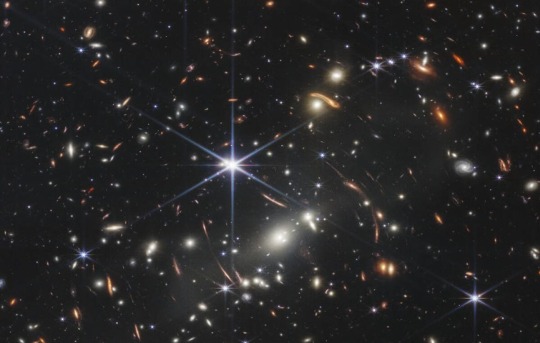
The astronomer Carl Sagan was famous for his quote in his book and film, Contact, “The universe is a pretty big place. If it’s just us, seems like an awful waste of space.” Yet, for some of us, it’s incredibly hard to fathom that it’s just us in the vast unknown full of so many stars and a growing list of exoplanets being discovered on a near daily basis. However, despite all our endless searching, we’ve so far found no one.
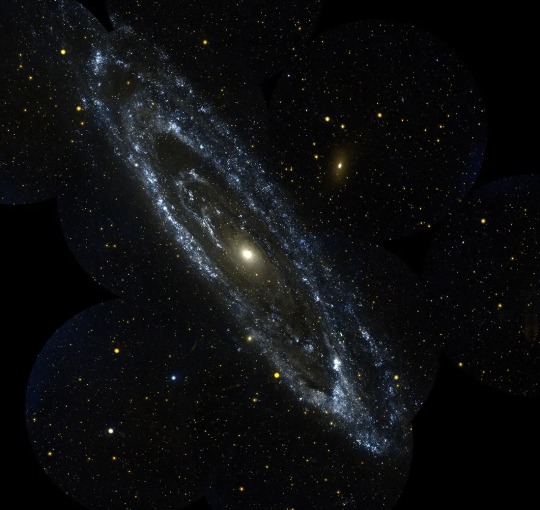
So, what if you found out one day that it is just us? What if in the great cosmos, out of all the planets, stars, and galaxies, we are truly alone? How would you look at the universe? At humanity? At yourself? Would you believe it? Would you stop looking up at the stars entirely? Would you feel disappointed that we’re alone, that we’re truly it, or would you feel a sense of optimism knowing that the longstanding question has finally been answered once and for all?
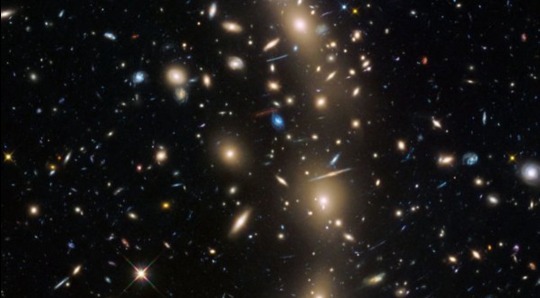
The film, Ad Astra, showed Roy McBride played by Brad Pitt searching for his father, H. Clifford McBride, played by Tommy Lee Jones, the latter of whom was on a mission at Neptune searching for intelligent life outside of the solar system and in the rest of the universe. In the end, Brad finds his dad alone on the space station orbiting Neptune, only to discover that his father didn’t find anything. No intelligent life anywhere in the universe. He discovered that we’re it.

Throughout the film, Roy was struggling to reconnect with his father and his father was struggling to connect with the universe, and this only serves as an appropriate analogy for our own pursuit of answering the longstanding question. At one point when he’s on Mars, Roy asks himself regarding his father, “I don’t know if I hope to find him or be free of him.” In our own pursuit of trying to answer the longstanding question, what if it’s not that we’re hoping to find intelligent life, but that we’re trying to be free of knowing if there’s intelligent life?
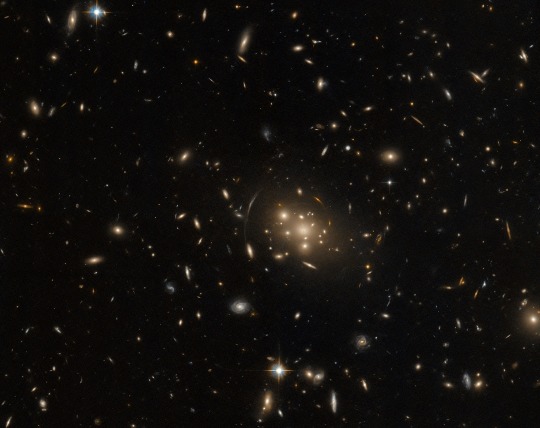
In the end, when Clifford disappointingly tells his son that there’s no one else in the universe and that he’s failed in his mission, Roy doesn’t respond with anger or disappointment, but with optimism, telling his estranged father with a smile, “Dad, you haven’t. Now we know. We’re all we’ve got.” In that moment, it was as if the literal weight of the universe was lifted from Roy’s shoulders knowing that we’re it. After Roy unfortunately leaves his father to die in the void, Roy notes that he can’t wait for the day that his solitude ends, and the film ends with him reconnecting with his wife.
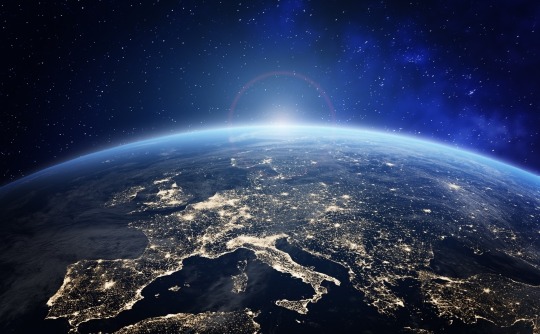
While Roy felt almost relieved to finally know the answer to the longstanding question, it’s important to ask if you’d feel the same way? Because, despite all the hopes of us finding intelligent life elsewhere in the universe, we must face the real possibility that we’re it. That’s it just us, and where do we go from here?
Are we alone in the universe?
Maybe we truly are.
Originally published on www.universetoday.com
COMING UP!!
(Wednesday, March 20th, 2024)
"IS DARK MATTER REAL??"
#astronomy#outer space#alternate universe#astrophysics#universe#spacecraft#white universe#space#parallel universe#astrophotography
58 notes
·
View notes
Text
WHAT IS BEYOND THE EDGE OF THE SOLAR SYSTEM??
Blog#383
Wednesday, March 13th, 2024.
Welcome back,
Earth is the sixth planet from the edge of the solar system, meaning we're none too near this cold and inhospitable frontier. But we've sent out various spacecraft over the years, so do we have any idea what the edge of the solar system looks like?
The answer is yes, but it's a work in progress. One of the latest developments, a 3D map of the solar system's edge that took 13 years to create, revealed a few more secrets about this mysterious boundary, called the outer heliosphere.
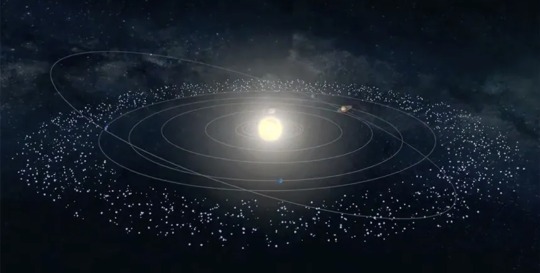
The outer heliosphere marks the region of space where the solar wind, or the stream of charged particles emitted from the sun, is "deflected and draped back" by the interstellar radiation that permeates the empty space beyond the solar system, said Dan Reisenfeld, a space science researcher at Los Alamos National Laboratory in New Mexico and head of the team that conducted the research on the 3D map. In other words, solar wind and interstellar particles meet and form a boundary at the far reaches of the solar system.

Earthlings first got a glimpse of the solar system's outer edge in 2012, when Voyager I, a NASA spacecraft that launched in 1977, crossed into interstellar space, according to NASA. Voyager 2 was not far behind, repeating the feat in 2018. Equipped with golden records full of Bach, Louis Armstrong and humpback whale songs, in addition to their scientific instruments, Voyagers 1 and 2 reported a sudden dropoff in solar particles and a substantial increase in galactic radiation when they left the solar system, according to NASA's Jet Propulsion Laboratory at the California Institute of Technology.
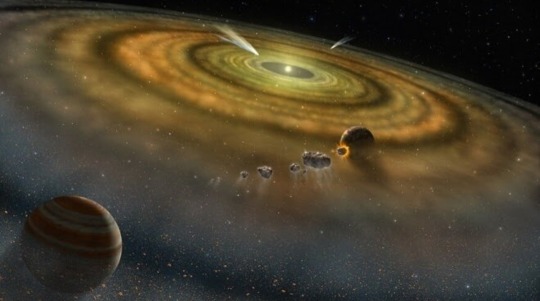
The new 3D map reveals even more about the heliosphere. The inner layer — where the sun and its planets are nestled — is roughly spherical and is thought to extend roughly 90 astronomical units (AU) in all directions. (One AU is the average distance between Earth and the sun, about 93 million miles, or 150 million kilometers.) The outer layer is much less symmetrical. In one direction — that in which the ever-moving sun plows through the space in front of it, encountering cosmic radiation — the outer heliosphere extends about 110 AU, but in the opposite direction, it's much longer, at least 350 AU, according to Reisenfeld.
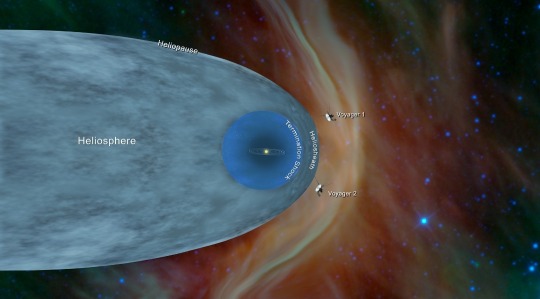
That lack of symmetry comes from the sun's movement through the Milky Way, as it experiences friction with the galactic radiation in front of it and clears out a space in its wake. "There's a lot of plasma [charged particles] in the interstellar medium, and… the inner heliosphere, which is pretty round, is an obstacle in this stream of plasma which is flowing past it," Reisenfeld told Live Science. "It has the same effect as water going around a rock in a stream," with a rush of water crashing into the rock in front and a sheltered calm behind it.
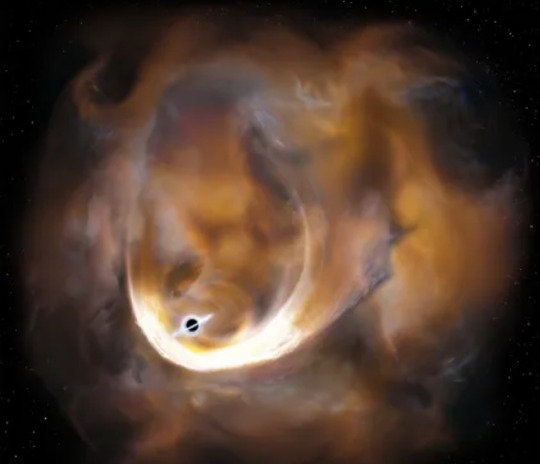
Measurements for the 3D map were gathered using the Interstellar Boundary Explorer (IBEX), which was launched in 2008 and is "the size of a bus tire," according to NASA. It's pronounced "like the animal," Reisenfeld said, referring to the ibex mountain goats known for their gravity-defying treks up alpine cliffs. But the animal that IBEX really takes after is the bat.

Many bats hunt insects, such as mosquitoes, by emitting a pulse of sound and using the time delay of the echo to figure out the distance to their prey. Likewise, IBEX detects solar-wind particles that have bounced back from the edges of the solar system, allowing Reisenfeld and his colleagues to determine the distances involved by measuring how long their round trip took.
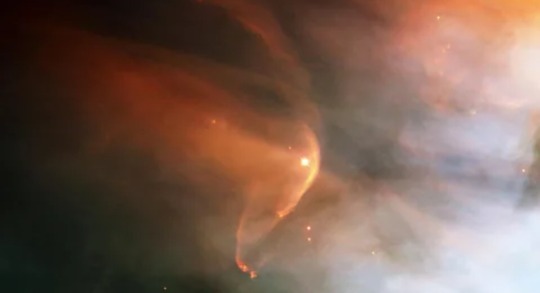
"The sun will send out a pulse … and then we passively wait for a return signal from the outer heliosphere, and we use that time delay to determine where the outer heliosphere must be," Reisenfeld explained.
As the sun circles the outer rim of the Milky Way, the solar wind keeps cosmic radiation at bay, forming a protective bubble. This is good for us, since "that radiation can damage spacecraft and it can be a health hazard for astronauts," Reisenfeld said.
Originally published on www.livescience.com
COMING UP!!
(Saturday, March 16th, 2024)
"WHAT IF WE ARE TRULY ALONE IN THIS UNIVERSE??"
#astronomy#outer space#alternate universe#astrophysics#universe#spacecraft#white universe#space#parallel universe#astrophotography
67 notes
·
View notes
Text
WHAT MAKES A BLACK HOLE GROW NEW STARS FROM??
Blog#382
Saturday, March 9th, 2024.
Welcome back,
When they are active, supermassive black holes play a crucial role in the way galaxies evolve. Until now, growth was thought to be triggered by the violent collision of two galaxies followed by their merger, however new research led by the University of Bath suggests galaxy mergers alone are not enough to fuel a black hole -- a reservoir of cold gas at the centre the host galaxy is needed too.
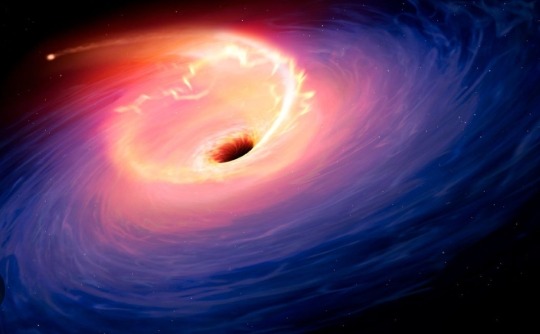
The new study, published this week in the journal Monthly Notices of the Royal Astronomical Society is believed to be the first to use machine learning to classify galaxy mergers with the specific aim of exploring the relationship between galaxy mergers, supermassive black-hole accretion and star formation. Until now, mergers were classified (often incorrectly) through human observation alone.
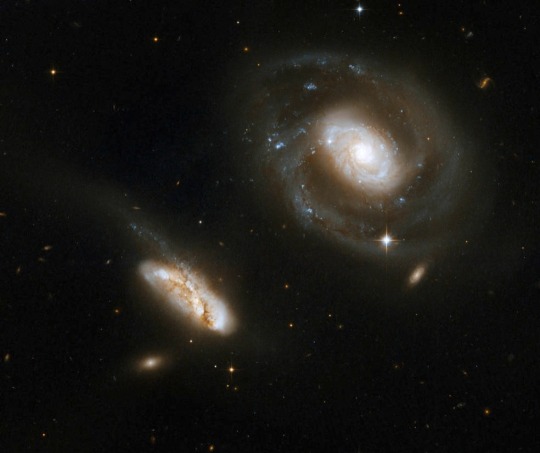
"When humans look for galaxy mergers, they don't always know what they are looking at and they use a lot of intuition to decide if a merger has happened," said Mathilda Avirett-Mackenzie, PhD student in the Department of Physics at the University of Bath and first author on the research paper. The study was a collaboration between partners from BiD4BEST (Big Data Applications for Black Hole Evolution Studies), whose Innovative Training Network provides doctorial training in the formation of supermassive black holes.

She added: "By training a machine to classify mergers, you get a much more truthful reading of what galaxies are actually doing."
Supermassive black holes are found in the centre of all massive galaxies (to give a sense of scale, the Milky Way, with around 200 billion stars, is only a medium-sized galaxy). These supersized black holes typically weigh between millions and billions of times the mass of our sun.

Through most of their lives, these black holes are quiescent, sitting quietly while matter orbits around them, and having little impact on the galaxy as a whole. But for brief phases in their lives (brief only on an astronomical scale, and most likely lasting millions to hundreds of millions of years), they use gravitation forces to draw large amounts of gas towards them (an event known as accretion), resulting in a bright disk that can outshine the entire galaxy.

It's these short phases of activity that are most important for galaxy evolution, as the massive amounts of energy released through accretion can impact how stars form in galaxies. For good reason then, establishing what causes a galaxy to move between its two states -- quiescent and star-forming -- is one of the greatest challenges in astrophysics.
"Determining the role of supermassive black holes in galaxy evolution is crucial in our studies of the universe," said Ms Avirett-Mackenzie.
Originally published www.sciencedaily.com
COMING UP!!
(Wednesday, March 13th, 2024)
"WHAT IS BEYOND THE EDGE OF THE SOLAR SYSTEM??"
#astronomy#outer space#alternate universe#astrophysics#universe#spacecraft#white universe#space#parallel universe#astrophotography
83 notes
·
View notes
Text
A GALAXY THAT HAS NO STARS??
Blog#381
Wednesday, March 6th, 2024.
Welcome back,
There’s a galaxy out there without apparent stars but largely chock full of dark matter. What’s that you say? A galaxy without stars? Isn’t that an impossibility? Not necessarily, according to the astronomers who found it and are trying to explain why it appears starless. “What we do know is that it’s an incredibly gas-rich galaxy,” said Green Bank Observatory’s Karen O’Neil, an astronomer studying this primordial galactic object. “It’s not demonstrating star formation like we’d expect, probably because its gas is too diffuse.”
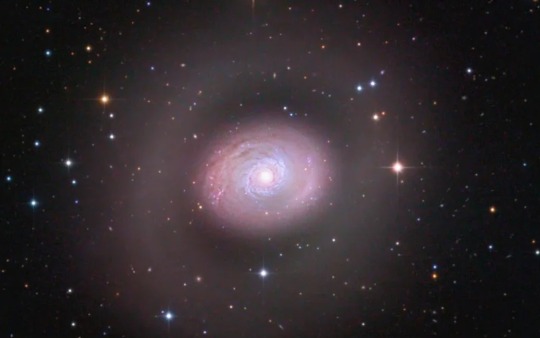
O’Neil and a team of colleagues found this odd, seemingly starless object called J0613+52, while they were doing a sky survey. Their target was a set of so-called “Low Surface Brightness” galaxies (LSBG) They used the Green Bank Telescope, the Arecibo Telescope (before its untimely end), and the Nançay Radio Telescope to look at 350 of these dim, diffuse objects. The idea was to survey them and determine their gas content and dynamic masses.
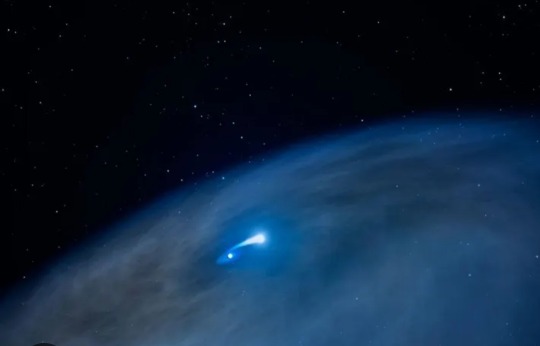
J0613+52 wasn’t one of the team’s original targets. Instead, they stumbled across it while trying to figure out why some of the data from Green Bank and Nançay didn’t match, according to O’Neil. “The GBT was accidentally pointed to the wrong coordinates and found this object,” she explained, noting that this galaxy was new and unknown. There are no galaxies within 112 parsecs, making it a pretty isolated target.

Interestingly, based on their observations, the team found that J0613+52 has about the same characteristics of mass and gas content as a normal spiral. Yet, it has no stars. That poses a mystery they’d like to solve.
The type of galaxy represented by J0613+52 is an odd one when you compare it to the more familiar types such as the star-filled spirals and ellipticals. For one thing, it’s a dwarf galaxy with an irregular shape. Without any obvious stars, it’s quite dim. The most unusual thing about objects like this one is that dark matter appears to dominate their compositions.

If J0613+52 is like others, it could have up to 95 percent dark matter constraining the neutral gaseous hydrogen that we can detect.
So, why no stars in J0613+52? O’Neil describes it as an “unevolved” dwarf. That’s because the neutral hydrogen gas component is too diffuse, and too spread out. LSBG generally have less gravity and that makes it tough to form stars on their own. So, they evolve very gradually. If they do start to convert gas to stars, it takes a long time for that to happen.
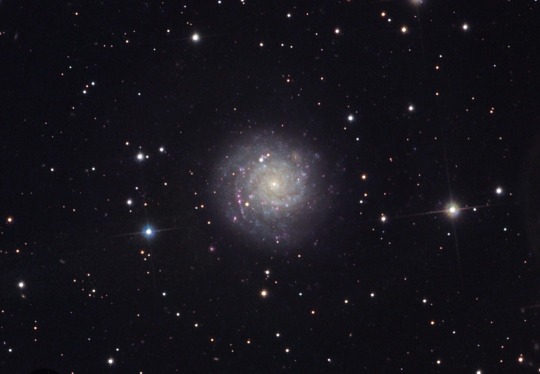
Some astronomers suggest that LSBG are late-forming objects in cosmic time. That might explain the presence of this one in relatively “modern” times.
In addition, J0613+52 lies too far from any neighboring galaxies to interact with them gravitationally. That means they can’t trigger star formation through any possible mergers or collisions. “J0613+52 appears to be both undisturbed and underdeveloped,” she said. “This could be our first discovery of a nearby galaxy made up of primordial gas.” That means its gas content is largely unchanged over time.
Originally published www.universetoday.com
COMING UP!!
(Saturday, March 9th, 2024)
"WHAT MAKES A BLACK HOLE GROW NEW STARS FROM??"
#astronomy#outer space#alternate universe#astrophysics#universe#spacecraft#white universe#space#parallel universe#astrophotography
109 notes
·
View notes
Text
HOW OLD IS PHOENIX A* BLACK HOLE??
Blog#380
Saturday, March 2nd, 2024.
Welcome back,
Black holes are the most massive objects that we know of in the Universe. Not stellar mass black holes, not supermassive black holes (SMBHs,) but ultra-massive black holes (UMBHs.) UMBHs sit in the center of galaxies like SMBHs, but they have more than five billion solar masses, an astonishingly large amount of mass. The largest black hole we know of is Phoenix A, a UMBH with up to 100 billion solar masses.
How can something grow so massive?

UMBHs are rare and elusive, and their origins are unclear. A team of astrophysicists working on the question used a simulation to help uncover the formation of these massive objects. They traced UMBH’s origins back to the Universe’s ‘Cosmic Noon‘ around 10 to 11 billion years ago.
Their paper is “Ultramassive Black Holes Formed by Triple Quasar Mergers at z = 2,” and it’s published in The Astrophysical Journal Letters. The lead author is Yueying Ni, a postdoctoral fellow at the Center for Astrophysics/Harvard & Smithsonian.

“We found that one possible formation channel for ultra-massive black holes is from the extreme merger of massive galaxies that are most likely to happen in the epoch of the ‘cosmic noon,'” said Ni.
UMBHs are extremely rare. Creating them in scientific simulations requires a massive, complex simulation. This is where Astrid comes in. It’s a large-scale cosmological hydrodynamical simulator that runs on the Frontera supercomputer at the University of Texas, Austin. Astrid’s large-scale simulations can track things like dark matter, temperature, metallicity, and neutral hydrogen.

Simulations like Astrid are ranked by the number of particles their simulations contain, and Astrid is at the top of that list.
“The science goal of Astrid is to study galaxy formation, the coalescence of supermassive black holes, and re-ionization over the cosmic history,” said lead author Ni in a press release. (Ni is a co-developer of Astrid.) A powerful tool like Astrid needs a powerful supercomputer. Luckily, UT Austin has the most powerful academic supercomputer in the USA.

“Frontera is the only system that we performed Astrid from day one. It’s a pure Frontera-based simulation,” she explained.
Astronomers know that galaxies grow large through mergers, and it’s likely that SMBHs grow more massive at the same time. But UMBHs are even more massive and much rarer. How do they form?

The team’s work with Astrid delivered an answer.
“What we found are three ultra-massive black holes that assembled their mass during the cosmic noon, the time 11 billion years ago when star formation, active galactic nuclei (AGN), and supermassive black holes, in general, reach their peak activity,” Ni said.
Originally published on www.universetoday.com
COMING UP!!
(Wednesday, March 6th, 2024)
"A GALAXY THAT HAS NO STARS??"
#astronomy#outer space#alternate universe#astrophysics#universe#spacecraft#white universe#space#parallel universe#astrophotography
100 notes
·
View notes
Text
THE OLDEST BLACK HOLE IN THE UNIVERSE!!
Blog#379
Wednesday, February 28th, 2024.
Welcome back,
Astronomers using the James Webb Space Telescope (JWST) have detected the earliest known black hole. Located more than 13 billion light-years away, it dates to a mere 400 million years after the Big Bang.
The black hole lies at the center of a galaxy called GN-z11, which, at the time of its discovery in 2016, was the oldest galaxy ever spotted. But what has shocked researchers about this early black hole is its large size.

“It’s not its age that is surprising, it is the fact that it is already so big so early in the universe, which is difficult to explain with standard theories,” Roberto Maiolino, a co-author of the study and astrophysicist at the University of Cambridge in the United Kingdom, tells Newsweek’s Jess Thomson.
Black holes are incomprehensible quantities of matter stuffed into a relatively small space. Because they’re so dense, their gravitational pull is powerful enough to suck in anything that comes close, including light.
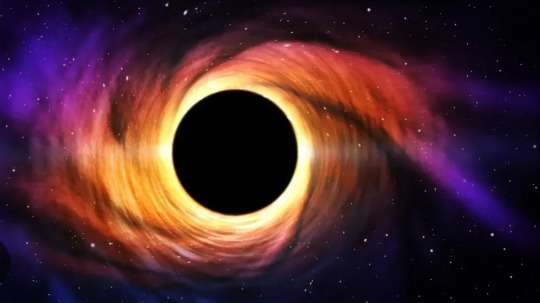
As a result, black holes can’t be observed directly—scientists can only see their effect on their surroundings.
In the case of the galaxy GN-z11, researchers had already noticed it was unusually bright. To be so luminous, “it would have required a large number of stars packed in such a small volume,” Maiolino tells NPR’s Ari Daniel.

But observations from Webb revealed the galaxy’s bright light doesn’t come from stars—instead, it’s from hot gas swirling around the black hole as it gets sucked inside. The findings were published Wednesday in the journal Nature.
“These authors have made a persuasive case that there is a black hole,” Priyamvada Natarajan, an astrophysicist at Yale University who did not contribute to the findings, tells NPR.

In November, Natarajan and other astronomers announced the discovery of what was, at the time, the earliest known black hole, dating to 470 million years after the Big Bang. The Webb telescope played a role in that discovery as well.
That black hole was also unexpectedly massive—between 10 million and 100 million times the mass of our sun.

“It’s just really early on in the universe to be such a behemoth,” Natarajan told Marcia Dunn of the Associated Press at the time.
The newly discovered black hole is roughly 1.6 million times as massive as our sun, according to Live Science’s Ben Turner.
Originally published on www.smithsonianmag.com
COMING UP!!
(Saturday, March 2nd, 2024)
" HOW OLD IS PHOENIX A BLACK HOLE??"
#astronomy#outer space#alternate universe#astrophysics#universe#spacecraft#white universe#parallel universe#astrophotography#space#blackholes#black holes
144 notes
·
View notes
Text
COULD THERE BE A 'DARK MIRROR' UNIVERSE WITHIN OURS??
Blog#378
Saturday, February 24th, 2024.
Welcome back,
What if the world of dark matter was a mirror of our own, just with a broken set of rules? That might explain why dark matter appears to be so abundant yet invisible, a new theory suggests.
Dark matter is the mysterious, unknown substance that seems to make up the bulk of all the mass in the universe; for every 2 pounds (1 kilogram) of regular matter, there's roughly 10 pounds (5 kg) of dark matter. It doesn't interact with light or normal matter.

The only way scientists can detect it is through its subtle gravitational influence on normal matter, such as the motions of stars within galaxies and the growth of super-large structures in cosmic time.
It might be easy to think that because matter and dark matter operate with different rules, one would be totally dominant over the other. But despite having wildly different properties, the amounts of normal matter and dark matter are still in the same ballpark. That seems like a strange coincidence.

To explain this, scientists proposed there could be some sort of hidden link between them. They published their research Jan. 22 on the preprint journal arXiv.
The researchers posited that for every physical interaction in normal matter, there's a mirror of it in the world of dark matter. This would be a new kind of symmetry in nature, connecting the normal and dark matter worlds, the researchers said.

This symmetry would help explain why dark matter and regular matter have roughly the same abundances.
In the paper, the researchers point out another strange coincidence. In the physics of normal matter, a neutron and proton have almost exactly the same mass, which enables them to bind together and form stable atoms. If a proton was just a little bit heavier, it would be totally unstable and decay in only a few minutes, making the formation of atoms impossible. In this imaginary scenario, the universe would be left with a sea of free-floating neutrons.

Perhaps, the researchers suggest, this imaginary, broken cosmos may be a reality in the dark matter mirror version of our universe. A special combination of physics led to a proton having roughly the same mass as a neutron; perhaps in the dark matter mirror, that combination of physics played out differently, causing the "dark proton" to evaporate and leave behind a sea of "dark neutrons" — what we identify as dark matter.

While this proposed mirror model allows for the possibility of rich interactions among dark matter particles — dark atoms, dark chemistry and a dark periodic table of dark elements — there can't be too much interaction, the researchers noted. If the dark matter interacts with itself a lot, it would tend to clump up far more than scientists think it does. So most of the dark matter has to be relatively simple — a sea of free-floating, neutral particles.
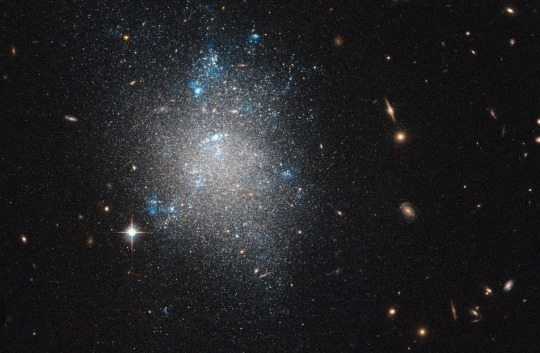
These additional interactions, which would be a dark mirror of our chemical world, may enable future scientists to test this theory. In the early universe, normal matter underwent nucleosynthesis, when the first elements formed in a nuclear plasma. If this new idea is correct, then there was a mirror nucleosynthesis also happening in dark matter.
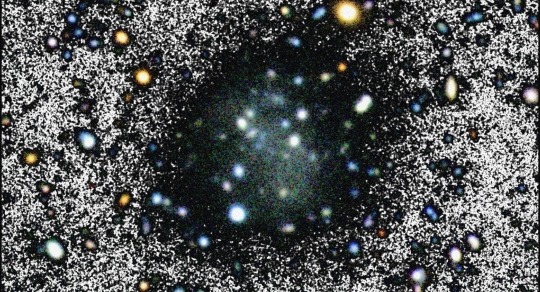
In those chaotic early days, channels may have opened up between the two worlds, enabling them to affect each other.
By carefully measuring the rate of element formation — something that the next generation of cosmological observatories hope to do — scientists may be able to find evidence for one of these channels and get a glimpse into the mirror dark universe.
Originally published on www.livescience.com
COMING UP!!
(Wednesday, February 28th, 2024)
"THE OLDEST BLACK HOLE IN THE UNIVERSE!!"
#astronomy#outer space#alternate universe#astrophysics#universe#spacecraft#white universe#space#parallel universe#astrophotography
70 notes
·
View notes